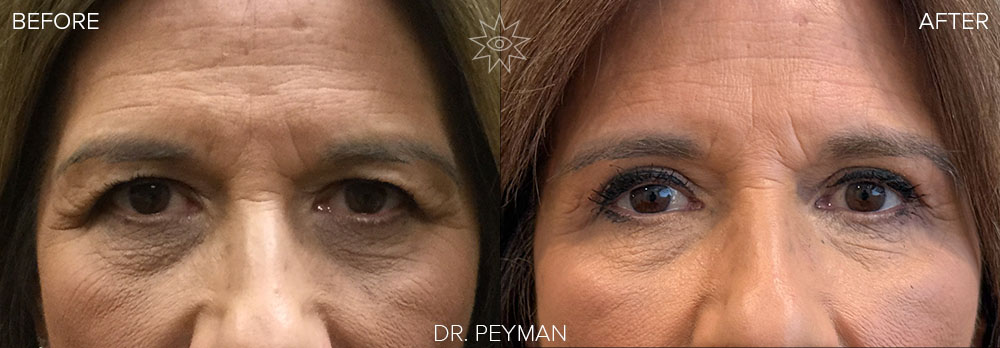
The best skin treatment to rejuvenate the skin and build collagen taking it back 10 years! While the procedure does have some recovery time, it works wonders for fine lines, wrinkles, scars, rosacea, and uneven skin tone. It can be performed alone in specific areas, or full face, neck, and decollete, or can be performed as a supplement to eyelid surgery. Typically 1 and done, this laser does not need to be repeated.
Contact Us to Book Your Appointment Today!

While eyelid surgery, or blepharoplasty, offers tremendous benefits from cosmetic enhancements to improved vision, the journey to facial rejuvenation doesn’t have to end there. In fact, to amplify the rejuvenating effects of blepharoplasty, many patients are adding laser skin resurfacing to the treatment plan.
What is Ablative Laser Skin Resurfacing?
Laser skin resurfacing is a non-surgical cosmetic procedure that utilizes CO2 laser in densely packed fractionated beams applied to the face to reduce wrinkles, blemishes, and scars. The skin will turn over in the course of 1 week. The laser technology stimulates the body’s natural healing process, promoting the growth of new collagen fibers, thereby improving the tone and texture of the skin.
Why Add Ablative Laser Skin Resurfacing to Your Eyelid Surgery?
1. Skin Rejuvenation: Upper eyelid surgery alone can dramatically improve the appearance of the eye area, but pairing it with laser skin resurfacing allows for more comprehensive facial rejuvenation. By targeting wrinkles, fine lines, and age spots, laser resurfacing enhances the refreshed, youthful look achieved through eyelid surgery.
2. Seamless Blend: This pairing helps to create a more seamless blend between the surgical area and the rest of the face. It addresses the contrast that can occur between the rejuvenated eye area and surrounding skin that may still show signs of aging.
3. Efficiency: Combining the two procedures allows patients to capitalize on recovery time. Rather than scheduling separate procedures with separate recovery periods, patients can recover from both procedures simultaneously.
4. Boost in Self-Confidence: Similar to eyelid surgery, patients who undergo laser skin resurfacing often report an increase in self-confidence and satisfaction with their appearance. The combined procedure can effectively address several common signs of aging, resulting in a more youthful and vibrant look.
Who is a Candidate?
The best candidate for laser skin resurfacing is the light-toned patient who is not likely to develop post-inflammatory hyperpigmentation. At times, we will do test spots to see how the skin responds to determine if you are a candidate. The procedure is suitable for individuals looking to treat wrinkles, fine lines, scars, age spots, or uneven skin tone. Your surgeon can provide a comprehensive assessment to determine if you are a good candidate
In Conclusion
To maximize the benefits of eyelid surgery, consider adding laser skin resurfacing to your treatment plan. This powerful combination can provide an overall refreshed, youthful appearance, boost your self-confidence, and streamline the rejuvenation process.

FAQ
What type of laser is used?
The ablative fractional carbon dioxide (CO2) laser is the type of laser skin resurfacing treatment that has been established and extensively utilized in facial rejuvenation. It’s highly effective for treating a range of skin conditions and is known for its ability to deliver dramatic results.
The term “ablative” refers to the removal of tissue. In this case, the CO2 laser precisely removes layers of skin in a fractionated method, meaning it treats only a fraction of the skin’s surface at a time. This leaves healthy skin in between the treated areas, promoting quicker healing and stimulating the body’s natural collagen production process.
Here’s a closer look at some of its benefits and uses:
Wrinkle reduction: By stimulating collagen production, this laser treatment can reduce the appearance of fine lines and wrinkles, particularly around the eyes and mouth, cheeks, and forehead.
Skin tightening: The heat generated by the laser can cause immediate tissue contraction, resulting in tighter skin.
Acne and surgical scars: The CO2 laser can effectively treat a variety of scars, helping to smooth out the skin’s texture.
Sun damage and pigmentation: The CO2 laser can also be used to treat sun damage, age spots, and other forms of pigmentation.
Skin texture improvement: By removing the outer layers of skin, this treatment can improve the skin’s texture and tone, leaving it smoother and more youthful.
The recovery time from an ablative fractional CO2 laser treatment generally ranges from one to two weeks, depending on the depth and intensity of the treatment. The skin will turn over and leave you with fresh new skin. Following all post-treatment care instructions will aid healing and accelerate the recovery process.
Is ablative laser skin resurfacing painful
Laser skin resurfacing with an ablative fractional carbon dioxide (CO2) laser is a high energy modality used to resurface the skin. Appropriate numbing creams and injections are applied prior to the procedure to lessen any sensation of heat and/or pain during the procedure. Usually patients are able to get through the procedure without difficulty; however, sensitivities can vary depending on the anesthetic used, individual’s pain tolerance, the specific treatment area, and the intensity of the treatment.
When it comes to treating the area surrounding the eyes, a very sensitive part of the face, metal eye shields are used to protect the eyes during treatment, and both topical numbing cream and local anesthetics are used to achieve minimal discomfort.
Following the procedure, some patients may experience a sensation of heat, similar to a sunburn, for the first few hours, but usually, by the evening of surgery, patients express no pain.
Proper aftercare is essential to minimize discomfort and promote healing. This includes avoiding sun exposure, diligently applying hydrating balms such as Aquaphor and doing vinegar soaks as directed, avoiding rubbing the skin, keeping the area clean, all of which will be thoroughly discussed at your preoperative appointment.

